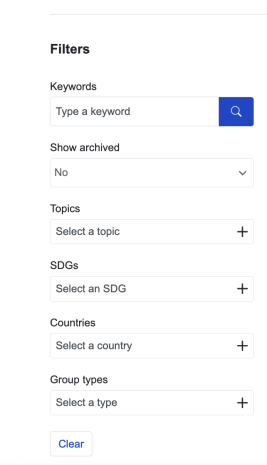Use Filters
Filters on the Capacity4dev website enable users to narrow down their search and quickly find relevant content. In this guide, we will explain how to use filters, such as keywords, show archived, topics, SDGs, countries, and group types, to efficiently locate the information you need.
Follow these steps to filter content on Capacity4dev:
- Step: Access the Capacity4dev homepage
- Step: Navigate to the "Browse Content" section
- Step: Apply filters to your search
- Step: Use specific filters to refine your search
Detailed steps
Step 1: Access the Capacity4dev homepage
- Visit the Capacity4dev homepage
- Log in to your account to ensure a personalised experience and access to all available filters. Click the "Login" button at the top of the page and enter your email address and password.
Step 2: Navigate to the "Browse Content" section
- Locate the main navigation bar at the top of the homepage and click on the "Browse Content" menu item to access the section where you can explore various types of content available on the platform.
Step 3: Apply filters to your search
- On the "Browse Content" page, you will see a list of content categories. Select a category, such as Groups, Projects, or Discussions, to access the corresponding content page.
- On the content page, locate the "Filters" section, on the left-hand side.
Image

Step 4: Use specific filters to refine your search
In the "Filters" section, you can apply various filters to narrow down your search. Some common filters include:
- Keywords: Enter specific keywords to find content related to your search terms.
- Show Archived: Check this box to include archived Groups/Projects/Resources in your search results.
- Topics: Select from a list of predefined topics to display content within that subject area.
- SDGs: Choose one or multiple Sustainable Development Goals to find content related to specific goals.
- Countries: Select a specific country to display content relevant to that geographical area.
- Group Types: Choose from different group types, such as public, restricted, or private to display content from those groups.
- Content Types: Select a type of content such as Groups, Projects, Articles or Resources.